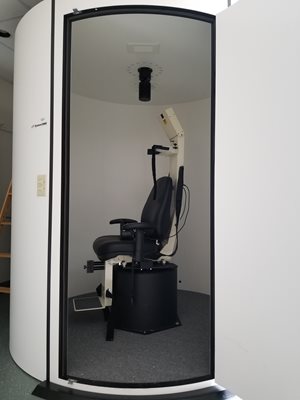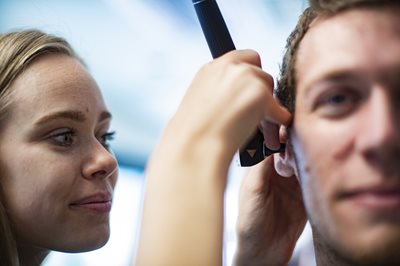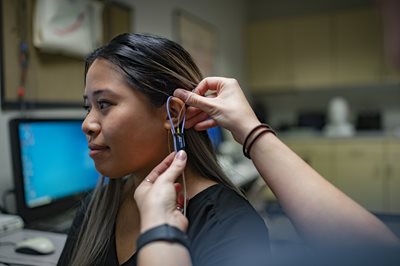Salus University’s Osborne College of Audiology (OCA) is a leader in innovative education, research and service in training students for the practice of audiological medicine. OCA, previously known as the Pennsylvania College of Optometry (PCO) School of Audiology up until 2008, has been inspiring innovative, competent and caring audiology professionals since 2000.
OCA is one of three Doctor of Audiology (AuD) programs in Pennsylvania and is home to four laboratories filled with state-of-the-art equipment in which students can utilize to gain hands-on experience. Each lab is equipped with technology most commonly used in audiology practices to best prepare students for clinical rotations, and future professional opportunities.
 The first of the four labs, the Vestibular Lab, is a space utilized for vestibular rehabilitation as well as the diagnosis of balance disorders. The equipment in the lab includes five vestibular stations, a Computerized Dynamic Posturography (CDP) system and one of fewer than 100 rotary chairs in the United States.
The first of the four labs, the Vestibular Lab, is a space utilized for vestibular rehabilitation as well as the diagnosis of balance disorders. The equipment in the lab includes five vestibular stations, a Computerized Dynamic Posturography (CDP) system and one of fewer than 100 rotary chairs in the United States.
"We have many ways to evaluate the balance/vestibular system at Salus University, including our rotary chair. The system allows us to see how the inner ear works while patients sit in a comfortable chair that turns at a slow to medium pace,” said Bre Myers, AuD, PhD, CH-AP, associate professor, OCA. “In the past 15 years, rotary chairs have become more popular, but access to them is still quite limited. Our students benefit from hands-on training during their time on campus which increases their ability to be placed at world-class externship sites."
Available to students from their first year in the program, the Audiometric Principles Lab is a space where they learn the foundations of testing and practice. The lab is equipped with four audiometers and four audiometric booths. Inside each booth are the various transducers (air and bone) necessary for standard testing as well as high-frequency headphones. The lab also features two stations for OtoSim - a computer-based program that allows users to view 150 pathologies of the ear, slides of histology and practice tests and exams for otoscopy and identification of pathology.
 “Instead of looking at a picture in a textbook, students are able to get hands-on practice holding an otoscope and looking into an ear,” said Jonette Owen, AuD ‘03, associate dean for clinical education and associate professor, OCA. “When working with the students in their first year, the OtoSim gives them an opportunity to see pathologies that they may not see in a clinical setting for several years.”
“Instead of looking at a picture in a textbook, students are able to get hands-on practice holding an otoscope and looking into an ear,” said Jonette Owen, AuD ‘03, associate dean for clinical education and associate professor, OCA. “When working with the students in their first year, the OtoSim gives them an opportunity to see pathologies that they may not see in a clinical setting for several years.”
The lab also has a teaching head otoscope which provides another lens for the instructors to see what students are looking at through the otoscope. This allows instructors to ensure students are using the equipment correctly and help guide them in the right direction.
The final two practice spaces are held within the Electrophysiology and Hearing Technologies lab. The electrophysiology portion of the lab has four stations to practice auditory brainstem response tests (ABR), otoacoustic emissions tests (OAEs), and mid- and late-latencies. These tests provide objective measures providing additional information on the health of the auditory system.
 The Hearing Technology section of the lab is outfitted with five Verifit® units (Verift® Classic and Verifit® 2) used to test the functionality of hearing devices and assist in accurate programming of the hearing devices to the individual patient's ear canal residence. Mannequins ranging from the most advanced CARL to basic styrofoam wig heads are also utilized in this lab for techniques such as hearing aid placement which gauge the correct tube length, adjust proper positioning, practice ear mold impressions, and cerumen (ear wax) management.
The Hearing Technology section of the lab is outfitted with five Verifit® units (Verift® Classic and Verifit® 2) used to test the functionality of hearing devices and assist in accurate programming of the hearing devices to the individual patient's ear canal residence. Mannequins ranging from the most advanced CARL to basic styrofoam wig heads are also utilized in this lab for techniques such as hearing aid placement which gauge the correct tube length, adjust proper positioning, practice ear mold impressions, and cerumen (ear wax) management.
The commonality between all four audiology labs is the large number of stations and equipment available for student use. “When George S. Osborne, PhD, DSS, founder of the PCO School of Audiology, initially designed the program, the vision was that we could accommodate a large cohort size,” said Dr. Owen, “The equipment we have available in all of our labs allows our large cohort of students to come practice without restricting the time they are allowed to be utilizing the equipment.”
OCA’s commitment to innovative education is heavily reflected through its labs, state-of-the-art equipment, and strong network of faculty. “Much of the technology we have available requires our faculty to be learning themselves on how to stay up to date with the equipment,” said Dr. Owen. “Our faculty is very supportive and open to their role in innovative education.”
To learn more about the opportunities available at the University’s Osborne College of Audiology, click here or contact admissions@salus.edu.